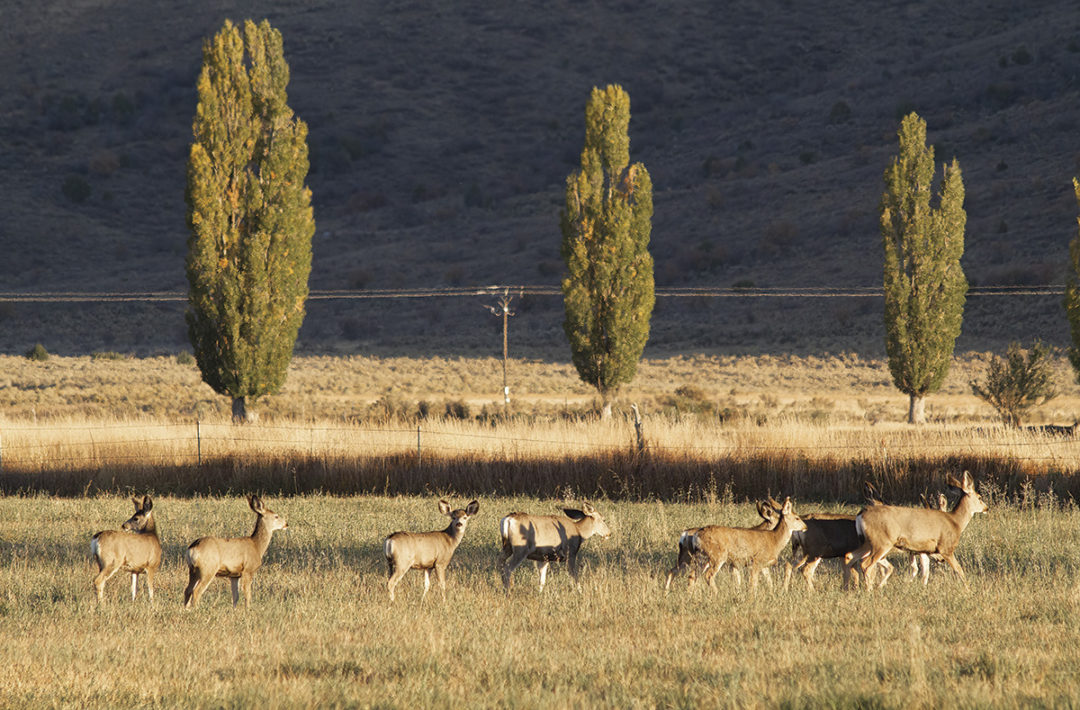“Elk and other big game can be a positive or a negative for a ranch, depending largely on how they impact the bottom line,” says Lesli Allison, executive director of Western Landowners Alliance. “If a ranch is able to derive sufficient income through hunting, ecotourism or government programs – such as the USDA Grasslands Conservation Reserve Program – then wildlife can be a benefit.”
Allison explains many ranches across the West operate on a diversified model, combining livestock with hunting, fishing, hosting guests, using ecosystem service markets and contributing to energy production. This approach delivers economic resilience both for the operation and the local community, while also supporting the environment.
“Sportsmen make significant contributions to sustainability through hunting license fees and taxes on guns and ammunition, but the investment of private landowners is also key to keeping the majority of essential habitat intact,” she says. “This includes critical winter forage, which is a primary limiting factor on big game populations.”
Wildlife maintenance and ranch viability
Allison believes maintaining this balance requires keeping these private, working lands intact and economically viable. This could mean limiting elk populations or enabling economic benefits for the true costs of sustaining wildlife.
Problems arise when costs outweigh their derivable benefits. For example, elk damage fences, consume hay, compete for forage and, in some regions, transmit brucellosis. While states offer various forms of compensation for some of those damages, they are often insufficient.
“When sustaining public wildlife doesn’t bring an economic benefit, it’s a problem, because it forces ranchers to choose how they react,” Allison stresses. “If there’s an opportunity to benefit from the habitat a well-managed operation is providing, there’s also a chance to increase and diversify income. If not, they could go out of business – then both the ranch and the habitat it supported are lost.”
Allison believes the ability to derive income from hunting big game depends on several factors, such as location and state policies. Some states, such as New Mexico, issue transferrable hunting licenses to landowners. They can then sell these tags, along with hunting access. Some states do not offer transferable tags, though large operations can still sell “trespass fees.”
Conflicting views
Allison says the North American Model of Wildlife Conservation, which believes wildlife belongs to the public, has been successful in regulating hunting and restoring big game populations. Nevertheless, many sportsmen are concerned about what they see as the “privatization” of elk by landowners who receive transferrable tags or charge trespass fees. She says growing elk populations in some parts of the West are challenging, and she encourages improved collaboration between all parties to balance the needs of the various stakeholder interests.
“When the interests of wildlife and ranching are pitted against one another, it’s a lose-lose situation,” Allison says. “Sportsmen and ranchers can and should be allies, helping one another be successful. Compensating landowners, including through transferrable tags, isn’t contrary to the North American model.”
Decision-making categories
Delwin Benson, emeritus professor and extension wildlife specialist at Colorado State University, views landowners' decisions in six general categories that he calls the “planning hexagon.” They include (1) economics/money/trade, (2) physical/biological processes, (3) individual/personal beliefs, (4) societal norms/culture, (5) legal/political systems and (6) logistical skills/technology/administration.
Ranchers must weigh economic costs and benefits before making conservation decisions. Often, these are heavily influenced by the biological processes of wildlife consuming grass, forbs and plants while occupying the same area as livestock. Personal convictions, alongside the pressure of cultural and group norms, may make it difficult to take action. Plus, strategies may be guided, positively or negatively, by legalities. Finally, logistics – including technology and administration – influence conservation actions.
“Ultimately, we can’t expect the landowner to provide the economics, management and sources that produce large ungulates and not allow them to get some of the rewards,” Benson says. “Technically, ranchers are often raising wildlife for the good of society. They’re birthed and grow up on the property, eating summer forage in higher altitudes or consuming it in the lower regions during the winter.”
Fitting compensation into the puzzle
Benson explains that it’s complicated and often difficult to deliver compensation.
“The logic is, if you own land, you should be given some permits to hunt these various species, based on management objectives,” he says. “Landowners can use or sell them.”
A straightforward method is to simply pay for forage losses, damaged fences and other losses. This comes with its own issues, as much of the funding for fish and wildlife agencies is derived from hunting and fishing license sales. In effect, funds to cover depredations indirectly come from sportsmen. This relationship often features mistrust.
Search for alternatives
Benson encourages landowners to seriously consider all potential alternatives. He admits that not all ranches, lands or people will find useful benefits, but those who look seriously at possibilities may find a way to enhance their overall enterprise.
“I’m not saying it’s easy,” he says. “It also may take time, but the agricultural community has shifted in the past. For example, many have switched from red to black cattle or vice versa. Some pivot from cattle to sheep. It’s the effect of a social decision that makes it palatable.”
Without a beneficial option, the alternative is undesirable for everyone.
“If a pasture is set aside for calving heifers and suddenly 250 elk move in and consume the grass, it isn’t a pleasant situation when no recourse is available,” Benson continues. “The rancher is left with callous and possibly discouraging tactics.”
Benson has spent much of his career helping landowners understand and see alternate values in the relationship between livestock and large wildlife. The reality is society wants elk, deer and moose on the landscape, and landowners and government officials must work together to make this possible from all viewpoints.
“I want to impress the value of thinking from the six sides of the hexagon,” he says. “Even with conflict or dietary overlap, can both sides benefit? It’s important we move the pendulum toward effective land and animal conservation, not only with a singular, narrow focus but in a broader sense.”









